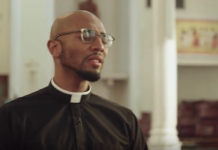
by Lisa Mladinich
God is not solitude, but perfect communion. For this reason the human person, the image of God, realizes himself or herself in love, which is a sincere gift of self (Pope Benedict XVI, Angelus, Solemnity of the Most Holy Trinity, Sunday, May 22, 2005).
Young and old, we are called to be saints. And since we realize our true selves through acts of love, it is critical for us, as catechists, to present the path of sanctity in ways that are attractive, relevant, and concrete to children.
The most effective programs emphasize a prayerful sacramental life and lead children to take action in ways consistent with the social teachings of the Catholic Church. These teachings run the gamut from protecting human life to protecting wildlife, and can be intimidating in their complexity. But the foundation upon which the whole structure is built is the life and dignity of the human person.
The Seven Themes of Catholic Social Teaching
Life and Dignity of the Human Person: Every life is precious to God, holy and worthy of protection and respect from conception to natural death. Our Church is the preeminent leader in the public debate on life issues including abortion, euthanasia, cloning and embryonic stem cell research, the death penalty, and global peace.
Call to Family, Community, and Participation: Marriage and family are the cornerstones of a healthy society, ordered to training children in faith and moral virtue, and working cooperatively for the common good. Catholics have a special sensitivity to marginalized persons in society and to building up social and political structures that empower the poor and vulnerable.
Rights and Responsibilities: Society is only healthy when human rights are protected and individuals uphold their responsibilities within families and communities. The two ideals are inseparably linked and cannot survive apart from each other.
Option for the Poor and Vulnerable: Societies are judged by how they treat their most defenseless members. We are called to make it our priority as Christians to feed the poor, protect the unborn, house the homeless, minister to those in prison, and speak for all those who lack a voice in society.
Dignity of Work and Rights of Workers: Human beings have a great need for the freedom of personal initiative, to work productively, to earn fair wages, and to maintain private ownership of personal goods. The Church calls us to build economies that respect the dignity of workers, encouraging them to create healthy families and communities.
Solidarity: Ours is a global human family, including all races and nations. For Catholics, the call to love one’s neighbor as oneself is a call to justice and peace in international matters, as well as within our own borders.
Care for God’s Creation: Morally and ethically, we are required to be good stewards of our natural environment. It is all part of being in healthy relationship with God and neighbor.
First Things First
Boston-area author and speaker Pat Gohn likens the social teachings of the Catholic Church to the Himalayan Mountain Range, with its incomparable heights. “I think most people can tell you, the greatest of those mountains is Mount Everest, the one that puts the others in its shadow. We have a lot of great teachings on social doctrines, all important. But the most important, the tallest, is the one you set your line of sight on: the Dignity of the Human Person. It is always the starting point; everything flows from that and points back to it.”
Pat uses the Dr. Seuss classic titled Horton Hears a Who with young children. “The story is all about personhood. ‘A person is a person, no matter how small,’” she quotes. “It’s very true to our conceptualization of the human person—and kind of interesting that it comes from an elephant who never forgets.”
“In his encyclical, Caritas in veritate,” Pat continues, “Benedict XVI suggests that if we get human ecology right, we’ll get planet ecology right!” But getting it right depends on a deeper commitment to prayer and sacramental life. “The graces of those Seven Sacraments empower us to love one another and serve the social mission of the Church. Teaching social doctrine in a vacuum outside of that falls flat because it has to come from this vibrancy of faith.”
Bringing it Home
New York catechist and parent Mike Graziose suggests that an “easy way to teach about life, solidarity, care for the poor, is with the children’s toys. I tell them that no matter what you have—any material thing—something about it will make you unhappy. It will get broken or there will be something you need for it.” With an emphasis on giving, the family donates toys, clothing, and money to the poor. “Our oldest is six, but they do, every once in a while, say something about how we can help the poor kids. We keep that as a mantra.”
New Hampshire writer Simcha Fisher shares her large family’s favorite charity. “‘Save a Family Plan’ is great because it connects your family directly with a family in dire need. You know exactly what their needs and goals are, and they send you a photo and a letter describing just exactly how your donation is put to work. It’s really important for kids to understand that charity isn’t vague or abstract or sentimental. It’s about real people with real problems. SAFP also stresses the dignity of the family in need.”
Lisa Ramseyer from Illinois combines the family Rosary with direct action. “Spiritual acts of mercy are just as important as the Corporal. What good is it to feed someone if you don’t give them Jesus?”
Along with their many volunteer activities, Lisa stresses respect for the environment at home and out in nature. “I believe there is no ‘greener’ family than those with many children living on one meager income. We stretch our dollars and see it not only as a way to help Dad out with the bills, but we do it also for the environment, the greater community, and to glorify God in simplicity by seeking to have a real detachment to material things. We don’t always hit the mark, but we try—and that’s part of being a sinner who wants to be a saint.”
“Large families are the new green,” agrees blogger and columnist Mary Ellen Barrett. “My family is leaving less of an impact on the earth simply by necessity. My children wear hand-me downs. I don’t buy fancy plastic water bottles or make unnecessary car trips. My car gets low mileage but rarely transports less than nine people, making it almost bus-like in its efficiency. We use the same amount of electricity as most people, since six kids can read in a room with one light bulb as easily as one or two.”
Parish Programs
Cay Gibson, author and DRE from Louisiana, shares an idea brilliant in its simplicity. “What we did was form little ministries for each grade level,” says Cay. “I gave out the ideas and the teachers have expanded on them.”
*Kindergarten and first grade minister to local nursing homes by making handmade gifts to be delivered by eleventh-grade Confirmation students.
*Second-graders and third-graders adopt a family in need, packing Thanksgiving and Christmas baskets, and collecting clothing and other needed items.
*Fourth-graders and fifth-graders pray for children profiled on foreign adoption sites and pack missionary boxes with travel-size toiletries to be sent to a foreign mission, the St. Bryce Foundation, in Costa Rica.
*Sixth-graders, seventh-graders, and eleventh-graders are involved with pro-life ministry, collecting donations in baby bottles for their local crisis pregnancy center.
*Eighth-graders and ninth-graders are planning ways to minister to military personnel.
*Tenth-graders and eleventh-graders support seminarians by raising money for gas cards, putting together spiritual bouquets, and making plans to attend ordinations to the deaconate and priesthood in the future.
*All grade levels collect canned goods for the St. Vincent de Paul Society, and the Confirmation students make deliveries.
Catechist and best-selling author Donna-Marie Cooper O’Boyle says, “It’s never too early to plant the seeds of charity in children’s hearts. I especially like to relate the teachable moments to a saint’s life, such as Blessed Mother Teresa. Of course, there are many other saints we can use as models of charity when encouraging children to live lives of loving service as we are called to do as Catholics.”
Bilingual catechist Jay Tellado teaches Hispanic inner-city teens in his Brooklyn parish. He gets them talking about the Church’s social teachings by challenging them to think about human dignity in reference to their own lives. At least once a semester he teaches the girls and boys separately, tackling issues of modesty and helping them to demand greater respect from the opposite sex. “You have to know how to read people, when to get tough, when to back down—making it relevant to them. I don’t teach from the outside. I build scenarios around them and their loved ones. I’ll say, ‘Give me an example in your household of what you think is a successful marriage, and why. And what is not a successful marriage, and why?’”
The Power of Youth Groups
New York teen Daria Rosien loves her parish Theology of the Body program, featuring videos by Jason and Cristalina Evert. Her youth group’s leadership program utilizes the YouCat and guest speakers. Daria is enthusiastic. “You have to know your faith. It’s the difference between management and leadership—not just getting through the day but being an example throughout the day of what you should be doing in your Christian life.”
When I ask South Carolina youth minister Mikael McKinney about inspiring teens to serve, he reveals his secret weapon. “We stick to the Sacraments. They love confession. I firmly believe that a successful youth group is centered around the Sacraments.”
Mikael takes teens on retreats to a Catholic-owned camp where they swim and hike and have lessons with guest speakers. But their favorite part is “flaming bush adoration,” as they call it, a three-quarter-mile procession up the mountainside to an outdoor monstrance in a stand “like a Christmas tree” surrounded by candles. “As each person venerates the monstrance, they put a candle on the stand,” explains Mikael. “It’s very dark and very beautiful. You see the passion of the teens and the presence of the Holy Spirit—the palpability of that—when we’re centered on the Sacraments. You just present it to them and they take the ball and run.”
One teen told Mikael she was greatly moved and finally “got” what adoration was about. “You’re actually with Jesus!” And the kids loved that their pastor was there for them, bringing them the Sacraments. “They say, ‘I can’t believe we had confession just for us!’” says Mikael.
High school junior Stephen Advent says, “The fall retreat was probably one of the most significant things in bringing my faith out and turning the Catholic faith into my own faith, not just my parents’. It was being with other people my age going through what I’m going through, the late night adoration in the mountains, and feeling close to Christ and feeling his presence there.”
“We focus on positive peer pressure,” says Mikael. “If you have youth going to the Sacraments and taking it seriously and loving Christ, younger people coming to the group and seeing that, they want to emulate it. Through positive peer pressure, youth are ministering to each other. We try to help them see the value of actually going to a soup kitchen, that it’s fun, and it’s redeeming. The graces received from that are more than you can imagine.”
The group’s activities include serving the homeless, pro-life activities, service hours with their parish’s St. Vincent de Paul Society, and helping out at the parish school.
As we strive to help young people sanctify their lives through social engagement, keeping the end in sight is key. We are journeying to our true home, together, our eyes on heaven.
Outreach Opportunities
* Americans United for Life (AUL, aulaction.org) harnesses social media, urging youth to call legislators and “donate” their tweets and Facebook activity once a month, calling their peers to action.
* Mission trips are a teen favorite. Contact Food for the Poor (foodforthepoor.org).
Heifer International (heifer.org) donates livestock to the poor and supports sustainable solutions to world hunger.
* The Frontline Faith Project (frontlinefaithproject.org) raises money to send free MP3 players pre-loaded with Catholic content overseas to servicemen and women.
*The Wounded Warrior Project (woundedwarriorproject.org) empowers communities and groups to raise money to assist those wounded in combat by providing physical and psychological healing and educational/vocational support.
Lisa Mladinich is the founder of Amazing Catechists (AmazingCatechists.com). and the author of Be an Amazing Catechist: Inspire the Faith of Children and Be an Amazing Catechist: Sacramental Preparation from Our Sunday Visitor.
Copyright 2013, Bayard, Inc. All rights reserved. This article is protected by United States copyright and other intellectual property laws and may not be reproduced, rewritten, distributed, redisseminated, transmitted, displayed, published or broadcast, directly or indirectly, in any medium without the prior written permission of Bayard, Inc.
This article was written by the Catechist Staff and appeared in Catechist magazine, June 2013.
Image Credit: Shutter Stock 399389878




